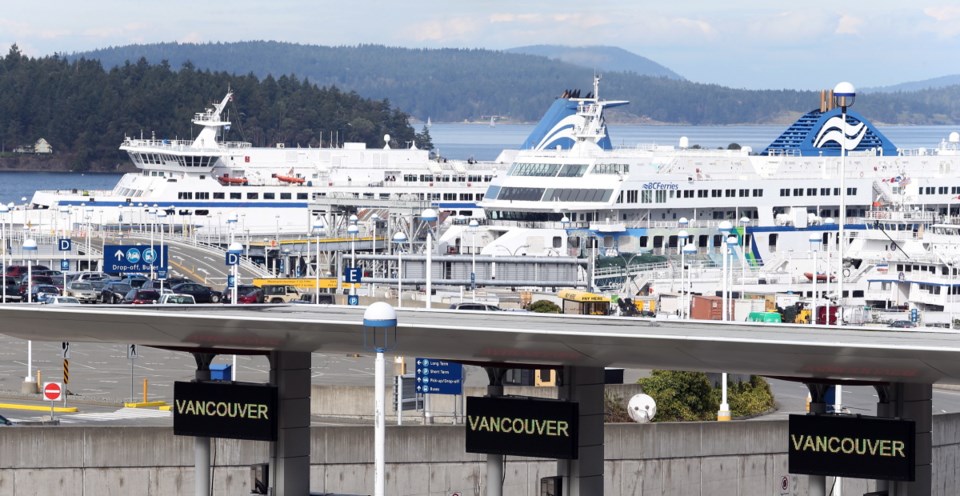A major earthquake would destroy almost all berths on B.C. Ferries’ major routes, cutting off vital supply lines to Vancouver Island, an engineer and former metal fabricator warn.
Ray Hebden and Greg Ramsay say only Swartz Bay’s Berth 2, a floating 180-metre long concrete pontoon connected to land by a ramp, would withstand a magnitude-9 quake.
Tsawwassen’s terminal could liquefy or sink below sea level, since it’s built on soft alluvial soil. Terminals at Duke Point, Horseshoe Bay and Departure Bay would be destroyed or severely damaged, they said.
“The main issue is: How would we get goods and services back and forth from the mainland?” Ramsay said.
Hebden and Ramsay were involved in designing and building the $25-million Berth 2 in 2006, along with Fraser Engineering and Vancouver Pile Driving.
Ramsay has since sold his company, Ramsay Machine Works, while Hebden has pitched similar floating berths for mainland terminals, which B.C. Ferries said would be costly.
A new 380-foot-long floating pontoon, built in Victoria and similar to Swartz Bay’s structure, will be towed to Langdale ferry terminal on the Sunshine Coast this weekend.
It is part of a terminal upgrade to be completed April 6.
Michael Pearson, B.C. Ferries’ senior project manager for terminal construction, said the Langdale structure will essentially be earthquake-resistant because it floats.
“[It] should be unaffected for the most part with an earthquake, although this structure itself is independent of the ramp structures that allow vehicles to transfer to and from the vessels,” Pearson said.
“This structure should be generally fine for post-disaster. But, of course, that doesn’t necessarily mean that the berth will be fine.”
B.C. Ferries spokeswoman Deborah Marshall said all terminals, berths and other structures were built to the seismic standards of the day. When it’s time to replace them, new structures are designed to current standards.
“B.C. Ferries plans to replace structures in a planned, organized and fiscally responsible manner,” Marshall said.
The age and seismic risk of structures are considered when setting priorities for upgrading, she said.
Seaspan, which delivers about 60 per cent of goods to Vancouver Island, is in the process of upgrading its terminal at Duke Point, chief financial officer Nancy McKenzie said. It will be built to the most up-to-date code and damage would depend on the severity of an earthquake.
The company has disaster recovery plans in place, so that operations can resume as soon as possible.
Information was not immediately available about Seaspan’s mainland terminals, but McKenzie noted that there are multiple docks from the Fraser River to the Port of Vancouver. “It would depend on the location of a disaster and where it impacted, but I would say that because we have vessels located across different areas of the Lower Mainland, it mitigates some of that risk.”
The Greater Victoria Harbour Authority is planning a review of its properties in the next two years to identify risks from earthquake, sea rise and storm surges, communications manager Jill Sawyer said.
Ogden Point is vulnerable to earthquakes because it’s built on fill, she said. A proposed master plan for the next 30 years would involve building and anchoring new structures to bedrock along Dallas Road, which is more seismically sound.
She said docks and piers at Ogden Point are expected to withstand an earthquake, but it would depend on the severity of shaking.
In a catastrophic earthquake, B.C. Ferries would be a vital link, says Emergency Management B.C.
“B.C. Ferries is a critical component of the provincial logistics system by connecting the mainland to the islands. Terminals, infrastructure, personnel and marine assets will be utilized to facilitate the transport of supplies, equipment and personnel,” the B.C. Earthquake Immediate Response Plan says.
But supplies could also be delivered by air, said Mary-Ellen Clark, EMBC’s executive director, logistics. “In a catastrophic earthquake, my team and I would be evaluating what supplies are needed and how to get in there.”
In a case where B.C. Ferries terminals are destroyed, other infrastructure such as roads would likely be damaged, she said.
The province is in the process of a developing critical supply chains to deliver food, water, medical supplies and personnel in case of a catastrophic event. It has identified what critical supplies may be needed and is figuring out how they will get to affected areas, she said.
If the Big One struck tomorrow, before the critical supply chain plan is in place, EMBC would look to a staff that has a breadth of international experience working in complex disasters. And having standard operating procedures is not necessarily as important as knowing how to adapt and make decisions in emergency situations, she said.
On Wednesday, the province announced $80 million in emergency preparedness funding. It included $800,000 for the Marine Environmental, Observation, Prediction and Response Network to identify critical marine infrastructure and study how deep each port is, in case an emergency means different vessels have to use them, Clark said.
The province recommends individuals have enough food and supplies at home to sustain themselves for a minimum of three days without help. Clark said EMBC is confident it will be able to get additional supplies to Islanders by that point.
A 2014 evaluation commissioned by B.C. Ferries found that in a large quake, Horseshoe Bay’s terminal would lose its lower ramp at Berth 1, have its retaining structures deformed and collapse and the southern section of its transfer deck would collapse.
“We consider that under earthquake action the loading structures will suffer damage that will render them inoperable,” the report said.
Information about other terminals was redacted in the document, which was released through a freedom of information request.
— with a file from Carla Wilson



